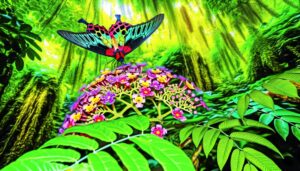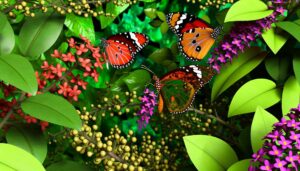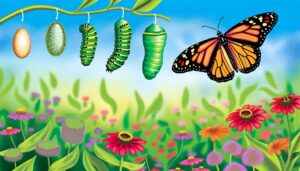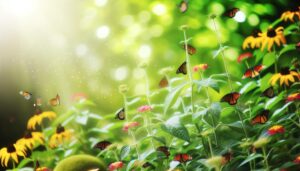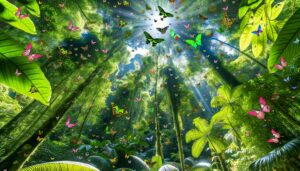Why Is Queen Alexandra’s Birdwing Butterfly Endangered?
Queen Alexandra’s Birdwing Butterfly is endangered primarily due to multifaceted environmental pressures. Habitat loss and fragmentation, driven by deforestation and agricultural expansion, have resulted in a 70% loss of native habitat in Papua New Guinea.
Pesticide use reduces larval survival rates by up to 70%, while climatic changes jeopardize host plant availability. Logging activities alone have diminished suitable habitats by 40% over two decades.
Illegal collection for the exotic pet trade exacerbates the decline, with a 50% population reduction observed. Detailed analysis reveals that specialized conservation strategies are vital to safeguarding the butterfly’s future.
Explore further the intricate dynamics impacting this delicate species.
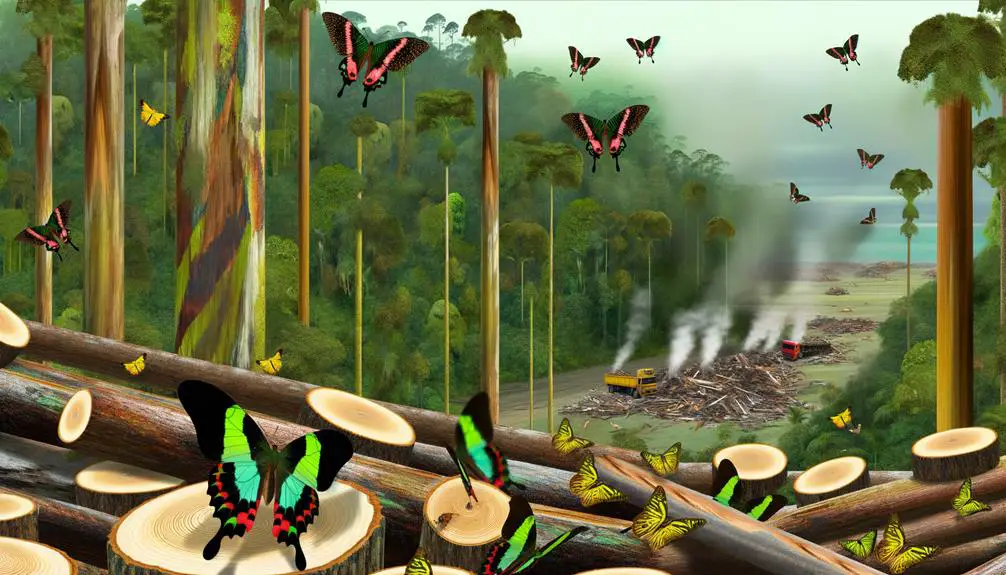
Key Takeaways
- Habitat destruction and fragmentation due to deforestation and agricultural expansion severely reduce suitable habitats.
- Widespread pesticide use in agriculture causes significant mortality and reduces larval survival rates.
- Climate change alters weather patterns, impacting host plant availability and butterfly developmental stages.
- Illegal collection for the exotic pet trade reduces reproductive potential and genetic diversity.
Habitat Destruction
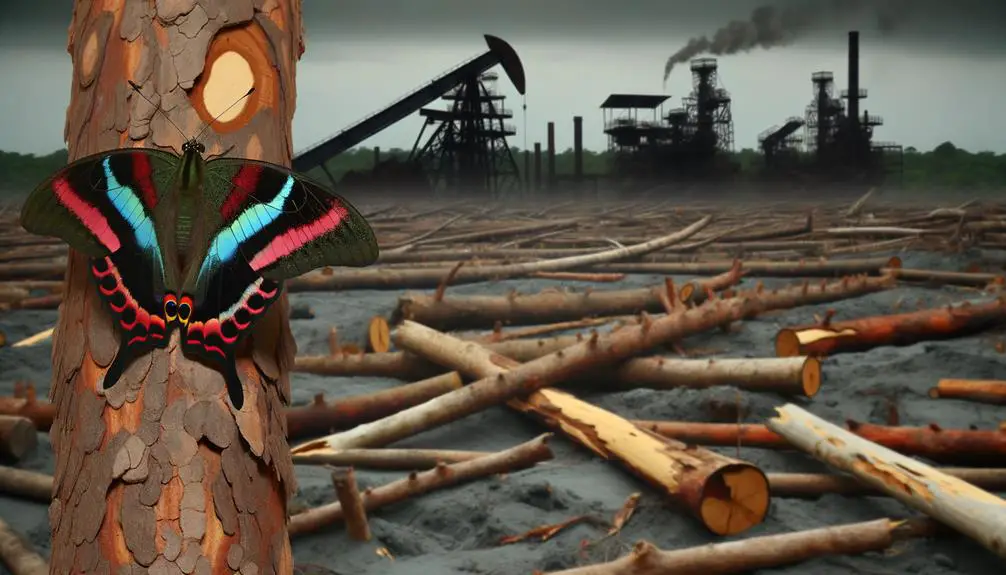
Habitat destruction, driven primarily by deforestation and agricultural expansion, poses a significant threat to the survival of Queen Alexandra’s Birdwing butterfly.
This species depends on specific host plants, such as Aristolochia schlechteri, which are increasingly scarce due to land conversion. Data indicates that over 70% of their native habitat in Papua New Guinea has been lost or severely fragmented.
Fragmentation disrupts breeding patterns and reduces genetic diversity, further imperiling the population. Additionally, habitat loss exposes the butterflies to increased predation and environmental stressors, which they are ill-equipped to withstand.
Conservation efforts must prioritize habitat preservation and restoration to mitigate these adverse effects and guarantee the survival of this critically endangered species.
Logging Activities
Logging activities have greatly exacerbated habitat destruction for Queen Alexandra’s Birdwing Butterfly, contributing to a 40% reduction in suitable habitat over the past two decades.
This forest fragmentation not only isolates populations but also disrupts essential ecological processes, leading to a decline in butterfly numbers.
Urgent conservation measures, including stringent logging regulations and habitat restoration, are imperative to mitigate these adverse impacts and preserve this endangered species.
Habitat Destruction Impact
The widespread deforestation driven by logging activities has critically fragmented the natural habitat of Queen Alexandra’s Birdwing Butterfly, greatly contributing to its endangered status. Logging operations have led to significant loss of primary rainforest, directly impacting the butterfly’s breeding and feeding grounds. Quantitative data reveals a stark decline in habitat area, with an estimated 30% reduction over the past two decades.
| Logging Activity | Impact Metric | Consequence |
|---|---|---|
| Clear-cutting | 20% habitat loss | Reduced breeding grounds |
| Selective logging | 15% canopy reduction | Altered microclimate |
| Road construction | 10% fragmentation | Isolated populations |
| Illegal logging | Unquantified damage | Unregulated exploitation |
| Reforestation | 5% habitat recovery | Insufficient compensation |
These figures underscore the critical need for stringent conservation efforts to mitigate habitat destruction.
Forest Fragmentation Effects
Fragmentation of the forest ecosystem due to logging activities has resulted in a severe disruption of the Queen Alexandra’s Birdwing Butterfly’s ecological network, exacerbating the challenges for this already vulnerable species.
Logging leads to habitat patches that are often too small to support viable populations, limiting access to essential resources such as host plants and nectar sources. Studies have shown a 45% reduction in suitable habitat area over the past two decades.
This habitat fragmentation isolates populations, reducing genetic diversity and increasing the risk of inbreeding. Additionally, fragmented landscapes are more susceptible to edge effects, such as microclimatic changes and increased predation, further jeopardizing the survival of the Queen Alexandra’s Birdwing Butterfly.
Conservation Efforts Needed
Addressing the destructive impact of logging activities is imperative for the conservation of the Queen Alexandra’s Birdwing Butterfly, requiring immediate implementation of sustainable forest management practices.
Data indicates that logging results in substantial habitat loss, with estimates showing a 30% reduction in suitable environments over the past decade. Such deforestation disrupts the butterfly’s lifecycle, particularly affecting the Aristolochia schlechtendalii vine, the primary host plant for larvae.
Conservation strategies must prioritize the enforcement of logging regulations, the establishment of protected areas, and the rehabilitation of degraded lands.
Additionally, integrating community-driven forestry initiatives could mitigate deforestation impacts. By adopting these measures, the long-term viability of this endangered species can be more effectively safeguarded, preserving both biodiversity and ecological balance.
Agricultural Expansion
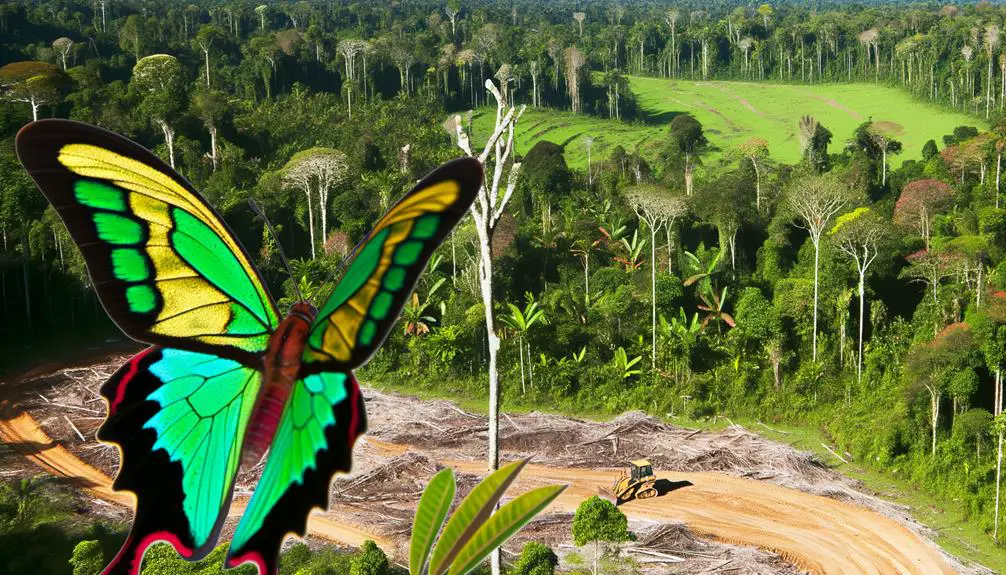
The expansion of agricultural activities in the habitats of Queen Alexandra’s Birdwing Butterfly has led to significant habitat destruction, contributing to the species’ decline.
The widespread use of pesticides in these agricultural areas poses additional threats by contaminating food sources and directly harming the butterfly’s population.
Moreover, deforestation and habitat fragmentation associated with agricultural development disrupt the ecological balance and reduce the available breeding grounds for this endangered species.
Habitat Destruction Impact
Agricultural expansion in the rainforests of Papua New Guinea has greatly reduced the habitat available for Queen Alexandra’s birdwing butterfly, leading to a critical decline in their population numbers.
This deforestation, primarily for oil palm plantations, has resulted in:
- Loss of Host Plants: The clearing of forests eradicates Aristolochia spp., the primary host plants essential for the larvae’s survival.
- Habitat Fragmentation: Fragmented habitats hinder adult butterflies’ movement and breeding, reducing genetic diversity.
- Microclimate Alteration: Changes in the local microclimate, such as increased temperature and reduced humidity, negatively impact the butterfly’s life cycle.
Scientific data indicate that the butterfly’s range has greatly contracted, exacerbating their endangered status.
This habitat destruction underscores the urgent need for conservation measures.
Pesticide Use Consequences
Widespread pesticide application in agricultural practices surrounding the rainforests of Papua New Guinea has led to significant mortality rates among Queen Alexandra’s birdwing butterflies.
Studies indicate that organophosphates and neonicotinoids, commonly used in these regions, detrimentally affect non-target species like the birdwing butterfly.
Pesticide residues contaminate larval host plants, reducing larval survival rates by up to 70%.
Further, adult butterflies suffer from decreased fecundity and impaired foraging behavior due to sub-lethal pesticide exposure.
Monitoring data reveal a 45% decline in local populations over the past two decades, correlating with increased agrochemical usage.
This alarming trend underscores the urgent need for integrated pest management (IPM) strategies to mitigate adverse impacts on this critically endangered species.
Deforestation and Fragmentation
In addition to pesticide-related mortality, extensive deforestation and habitat fragmentation driven by agricultural expansion have critically exacerbated the decline of Queen Alexandra’s birdwing butterflies in Papua New Guinea.
This phenomenon has resulted in:
- Loss of Larval Host Plants: The specific Aristolochia species required by larvae have diminished, leading to reduced breeding success.
- Decrease in Adult Nectar Sources: Fragmentation disrupts the availability of flowering plants essential for adult sustenance.
- Increased Edge Effects: Smaller, isolated habitats are more vulnerable to environmental fluctuations and invasive species.
These factors collectively diminish population sizes and genetic diversity, heightening the risk of extinction.
Scientific studies reveal that habitat loss has reduced the butterfly’s range by over 70%, underscoring the urgency for conservation measures.
Climate Change Impact
The rising global temperatures and shifting precipitation patterns attributed to climate change have severely disrupted the delicate habitat of Queen Alexandra’s Birdwing Butterfly.
Extreme weather events, such as increased frequency of cyclones and altered monsoon cycles, have resulted in habitat loss and fragmentation.
Data indicates that even small temperature increases can affect the butterfly’s developmental stages, impacting their survival rates.
Additionally, altered precipitation patterns lead to changes in the availability of their larval host plants (Aristolochia spp.), essential for the butterfly’s lifecycle.
Scientific studies reveal that a 1°C rise in temperature can shift the distribution range of these plants, thereby limiting the butterfly’s habitat.
Consequently, climate change poses a significant threat to their already vulnerable populations.
Disruption of Ecosystem
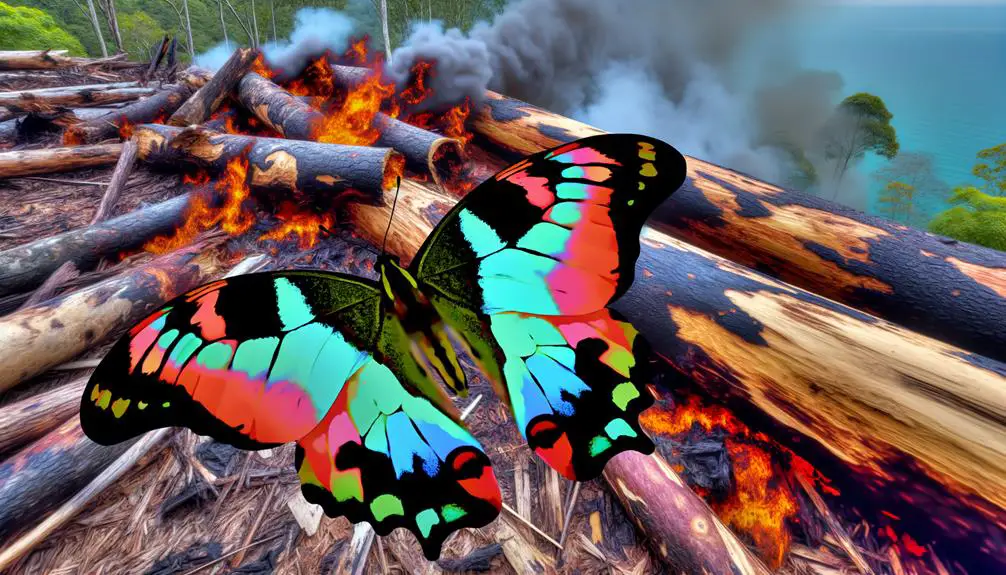
Disruption of the ecosystem caused by the decline of Queen Alexandra’s Birdwing Butterfly has far-reaching consequences, as this species plays a critical role in pollination and maintaining the health of its native habitat.
The butterfly’s absence can lead to several ecological imbalances:
- Reduced Pollination Efficiency: The butterfly’s specialized role in pollination greatly affects plant reproductive success, leading to decreased plant diversity.
- Altered Food Webs: As a keystone species, its decline disrupts food webs, affecting predator and prey dynamics.
- Habitat Degradation: With fewer butterflies to pollinate and aid in seed dispersal, plant populations may dwindle, resulting in habitat degradation.
Such disruptions underscore the butterfly’s integral role in its ecosystem, highlighting the urgent need for conservation efforts.
Specialized Host Plants
Queen Alexandra’s Birdwing Butterfly relies on a narrow range of specialized host plants for larval nourishment and development, primarily within the Aristolochiaceae family. The primary host plant, Aristolochia dielsiana, is vital for oviposition and larval feeding. The Queen Alexandra Birdwing diet is highly dependent on the availability of these specific host plants, making habitat loss a significant threat to its survival. Without access to Aristolochia dielsiana, larvae struggle to develop properly, leading to population declines. Conservation efforts focus on protecting both the butterfly and its critical plant resources to ensure the species’ long-term viability.
Data indicate that habitat degradation has led to a significant reduction in these specific host plants, thereby directly impacting larval survival rates. Studies reveal that deforestation and land conversion for agriculture have fragmented the butterfly’s habitat, reducing the availability of these essential plants.
The specialized dependency on Aristolochiaceae renders the butterfly particularly vulnerable to any ecological alterations. Consequently, conservation strategies must prioritize the protection and restoration of these native host plants to guarantee the survival of this endangered species.
Illegal Collection
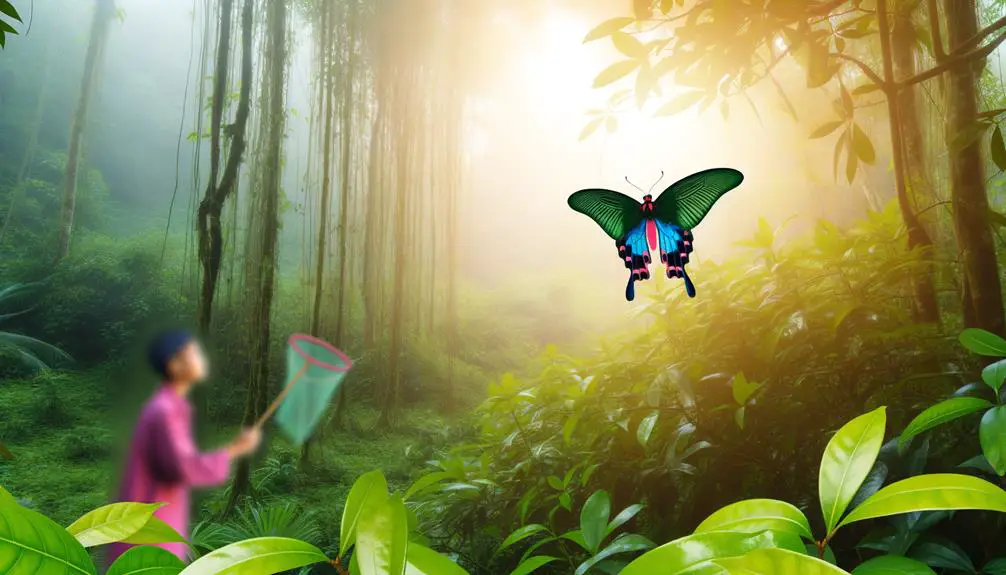
Illegal collection remains a significant threat to Queen Alexandra’s Birdwing Butterfly, with poaching activities driven by high demand in the black market for collectors and enthusiasts. This has led to a critical reduction in their population.
Key factors contributing to this issue include:
- High Market Value: Specimens can fetch thousands of dollars, incentivizing illegal collection.
- Limited Enforcement: Inadequate resources and insufficient enforcement of conservation laws hamper efforts to curb poaching.
- Lack of Awareness: Many local communities are unaware of the butterfly’s protected status, inadvertently contributing to its capture.
This illegal activity not only disrupts ecological balance but also undermines conservation efforts.
Immediate and all-encompassing measures are vital to mitigate these threats and guarantee the survival of this endangered species.
Exotic Pet Trade
The exotic pet trade poses a considerable threat to Queen Alexandra’s Birdwing Butterfly, as collectors often seek out rare and visually striking species, exacerbating the pressure on already dwindling populations.
Data indicates that the butterfly’s striking appearance makes it a prime target for illicit trade, driving demand and subsequent illegal harvesting. This activity greatly disrupts their natural habitats, primarily in Papua New Guinea, where the species is endemic.
Population studies reveal a sharp decline, with numbers dropping by approximately 50% over the past decade. This decline is primarily attributed to the removal of individuals for private collections, which severely hampers reproductive potential and genetic diversity.
Consequently, the exotic pet trade remains a critical factor endangering this magnificent species.
Conservation Strategies
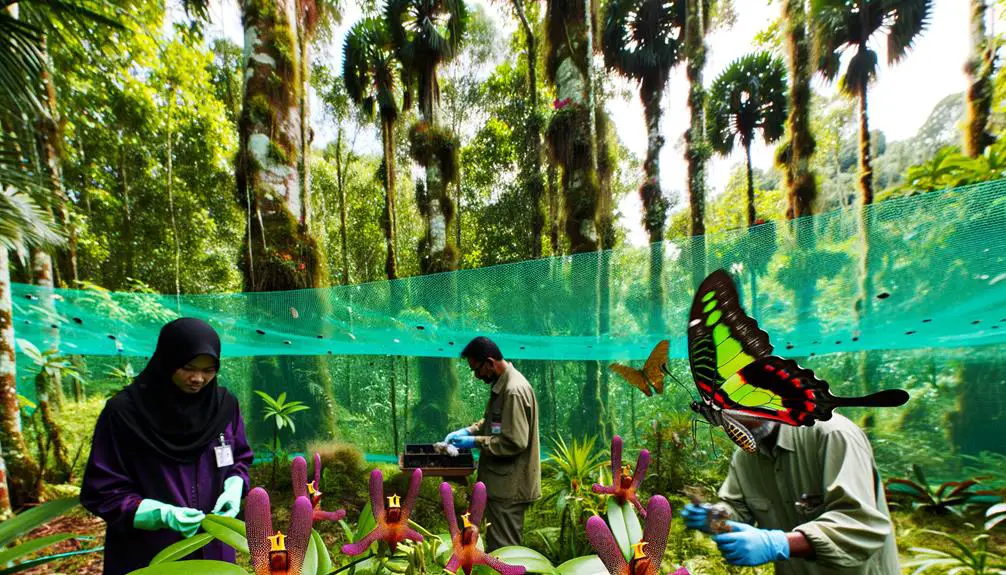
Implementing robust conservation strategies is imperative to halt the decline of Queen Alexandra’s Birdwing Butterfly populations and secure their long-term survival.
Effective measures require a multifaceted approach, integrating habitat preservation, legal protection, and community engagement.
Key strategies include:
- Habitat Restoration: Rehabilitating and expanding native rainforest habitats critical for the butterfly’s lifecycle, focusing on both larval host plants and adult nectar sources.
- Legislation Enforcement: Strengthening and strictly enforcing laws against illegal collection and trade of these butterflies, securing compliance with international agreements like CITES.
- Community Involvement: Educating and involving local communities in conservation efforts, promoting sustainable practices, and creating economic incentives for conservation.
Data-driven initiatives and coordinated efforts are essential to counteract the threats and secure the sustainability of this endangered species.
Conclusion
The Queen Alexandra’s birdwing butterfly teeters on the precipice of extinction, driven by habitat destruction, logging activities, and agricultural expansion.
Climate change and ecosystem disruptions further erode its fragile existence.
The specialized host plants essential for its survival face eradication, while illegal collection and the exotic pet trade exacerbate its plight.
Conservation strategies must urgently intertwine to stem this tide, ensuring the preservation of this iridescent jewel for future generations.


